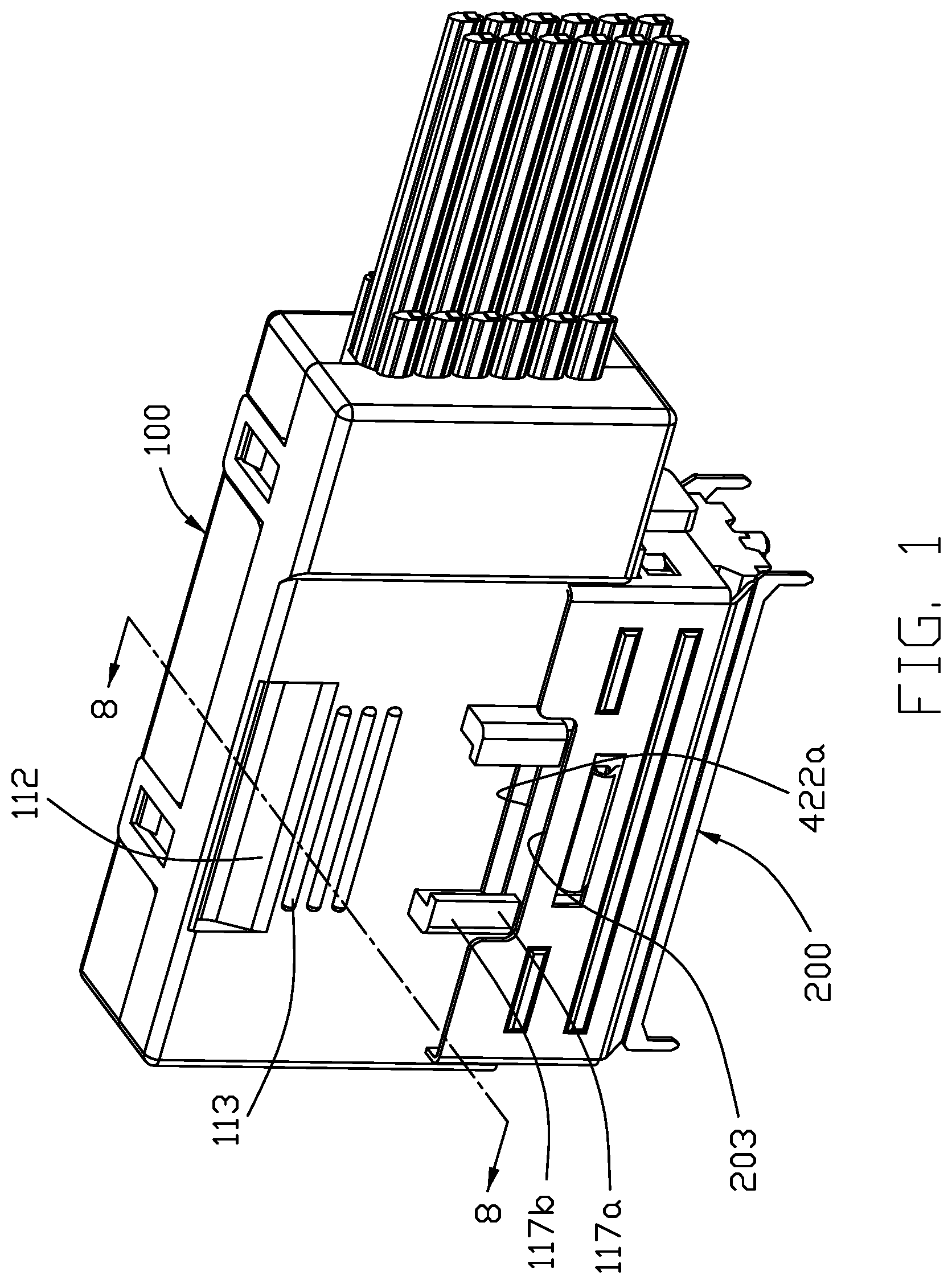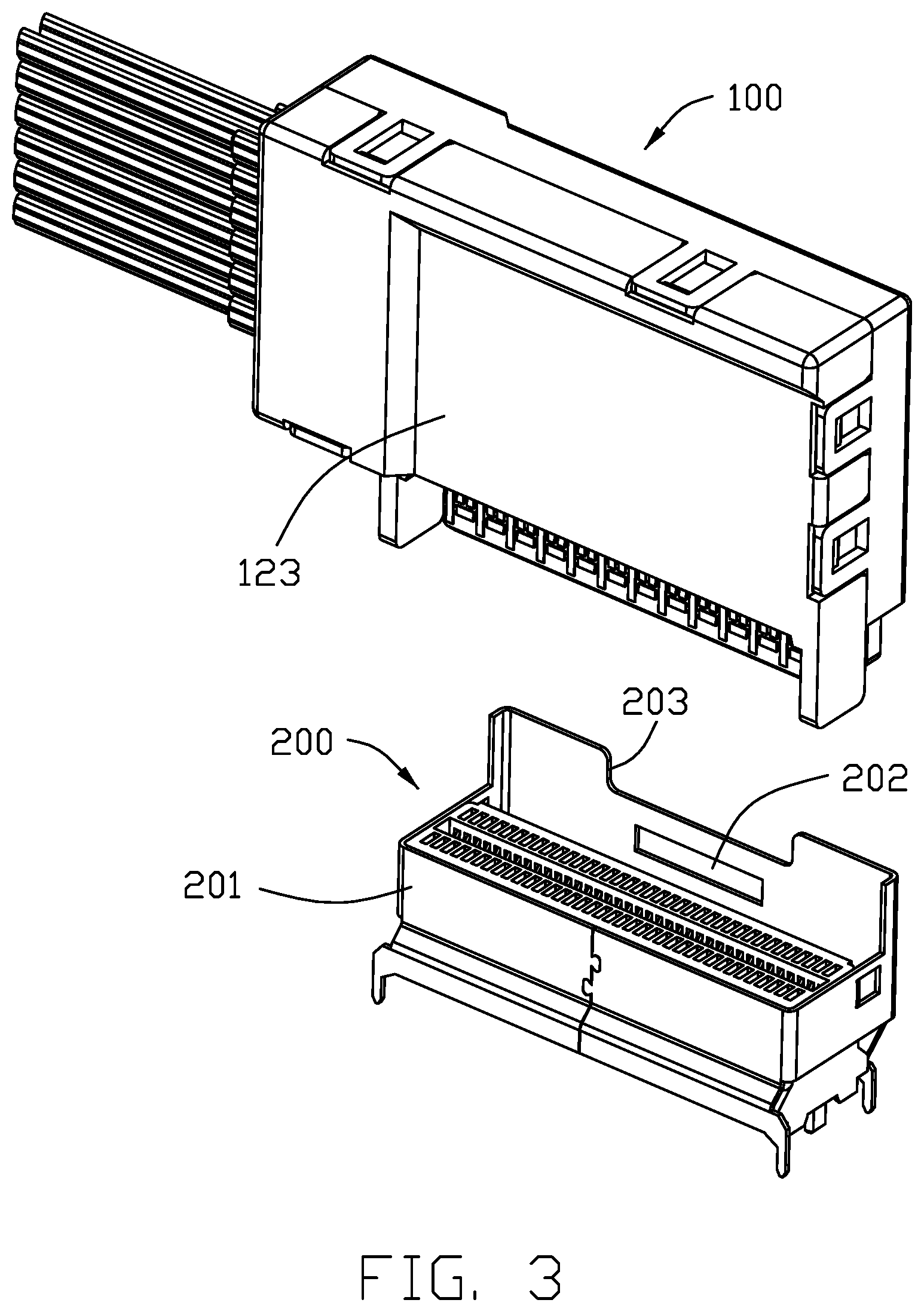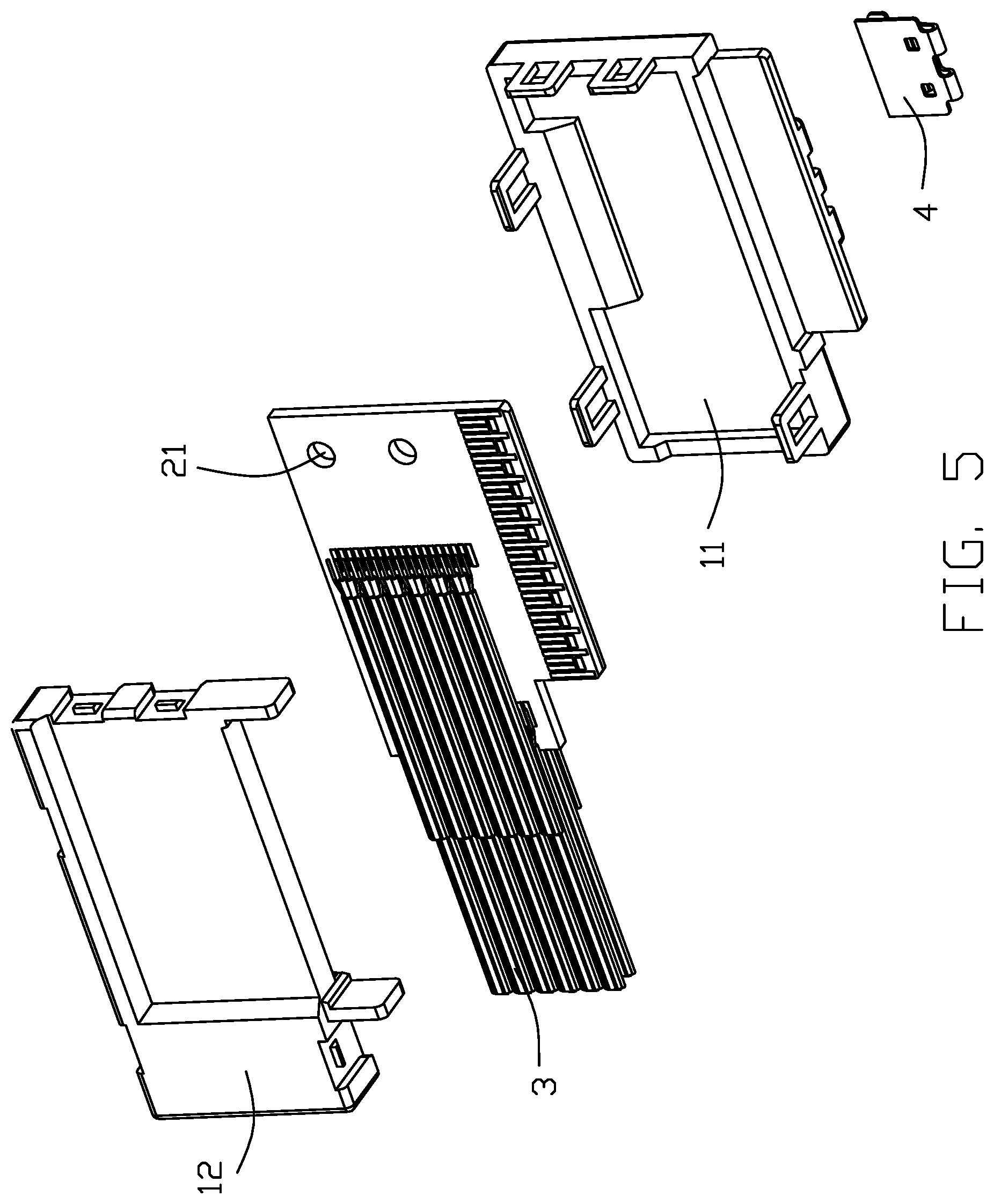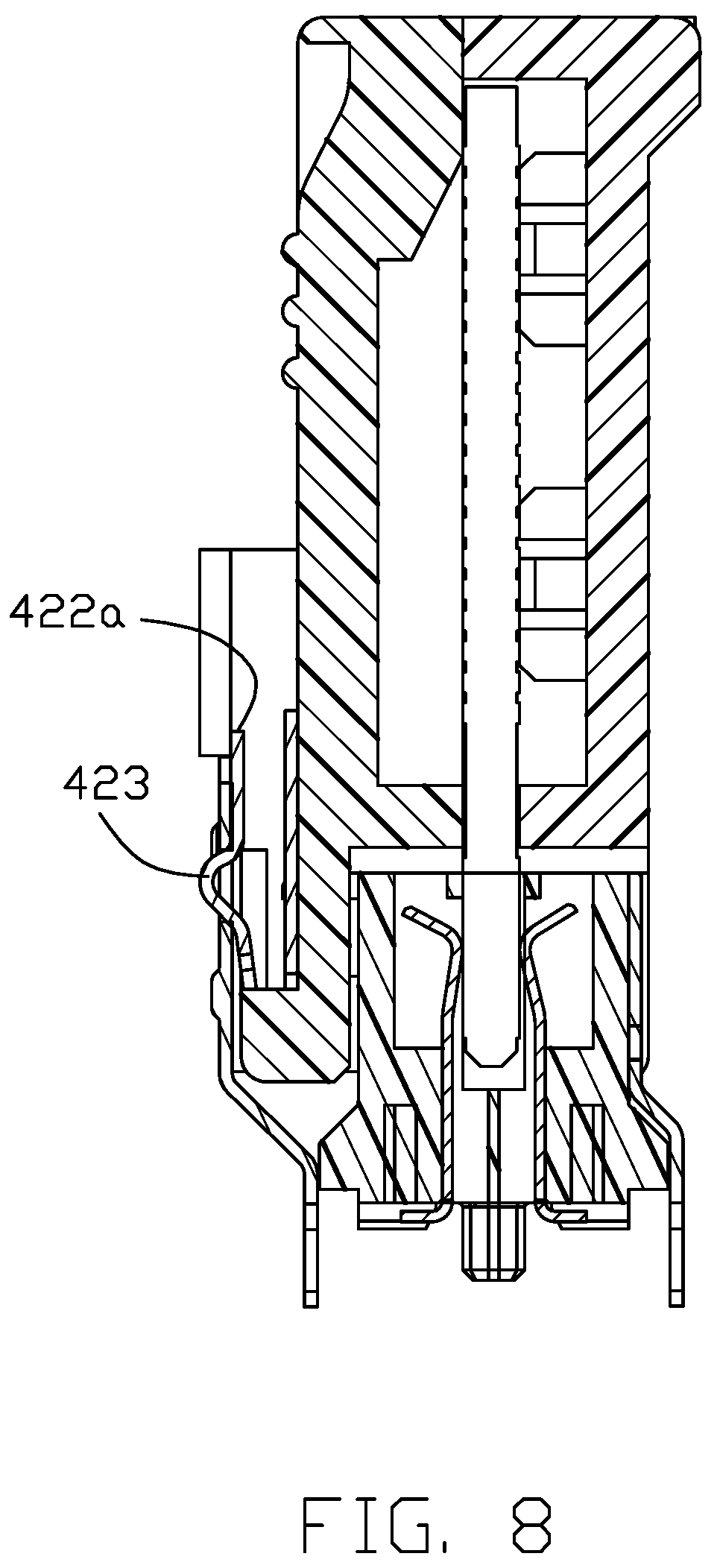Plug Connector Assembly
WU; JERRY ; et al.
U.S. patent application number 16/724200 was filed with the patent office on 2020-06-25 for plug connector assembly. The applicant listed for this patent is FOXCONN (KUNSHAN) COMPUTER CONNECTOR CO., LTD. FOXCONN INTERCONNECT TECHNOLOGY LIMITED. Invention is credited to JUN CHEN, FAN-BO MENG, JERRY WU.
| Application Number | 20200203886 16/724200 |
| Document ID | / |
| Family ID | 71097917 |
| Filed Date | 2020-06-25 |










| United States Patent Application | 20200203886 |
| Kind Code | A1 |
| WU; JERRY ; et al. | June 25, 2020 |
PLUG CONNECTOR ASSEMBLY
Abstract
In a plug connector assembly, a plug connector for mating with a receptacle connector, includes: a shell and a locking spring mounted on the shell and including a mating curved surface for directly locking to and unlocking from a receptacle connector
| Inventors: | WU; JERRY; (Irvine, CA) ; CHEN; JUN; (Kunshan, CN) ; MENG; FAN-BO; (Kunshan, CN) | ||||||||||
| Applicant: |
|
||||||||||
|---|---|---|---|---|---|---|---|---|---|---|---|
| Family ID: | 71097917 | ||||||||||
| Appl. No.: | 16/724200 | ||||||||||
| Filed: | December 21, 2019 |
| Current U.S. Class: | 1/1 |
| Current CPC Class: | H01R 12/62 20130101; H01R 12/721 20130101; H01R 13/6275 20130101; H01R 13/6272 20130101; H01R 13/665 20130101 |
| International Class: | H01R 13/627 20060101 H01R013/627; H01R 13/66 20060101 H01R013/66; H01R 12/62 20060101 H01R012/62 |
Foreign Application Data
| Date | Code | Application Number |
|---|---|---|
| Dec 21, 2018 | CN | 201811570116.3 |
Claims
1. A plug connector for mating with a receptacle connector, comprising: a shell; and a locking spring mounted on the shell and including a mating curved surface for directly locking to and unlocking from a receptacle connector.
2. The plug connector as claimed in claim 1, wherein the locking spring includes a holding portion held on the shell, the mating curved surface includes an insertion curved surface extending upward from the holding portion, a protruding portion located at the topmost end, and an exit curved surface extending downward from the protruding portion.
3. The plug connector as claimed in claim 2, wherein the shell includes an upper casing and a lower casing mated with the upper casing.
4. The plug connector as claimed in claim 3, wherein the upper casing includes a plurality of protruding sections to hold the holding portion of the locking spring.
5. The plug connector as claimed in claim 3, wherein the upper casing includes a plurality of protruding ribs and a groove located behind the protruding ribs, the lower case is provided with a step portion for gripping.
6. The plug connector as claimed in claim 3, wherein the lower casing includes a plurality of limiting portions extending along the mating direction and a plurality of positioning posts at the front end of the lower casing.
7. The plug connector as claimed in claim 6, further including a printed circuit board received in the shell, the printed circuit board including a plurality of mating holes aligned with the positioning posts.
8. The plug connector as claimed in claim 7, wherein the positioning posts pass through the mating holes to abut the rear end of the upper casing to fix the printed circuit board.
9. The plug connector as claimed in claim 7, further including a cable electrically connected to the printed circuit board in a left-to-right direction perpendicular to the mating direction and extending in the horizontal direction.
10. The plug connector as claimed in claim 9, wherein the printed circuit board includes a plurality of soldering pads on both sides of the printed circuit board to connect with the cable.
11. An electrical connector assembly comprising: a plug connector for mating with a receptacle connector and including a shell and therein a vertical printed circuit board extending along a vertical direction with a bottom edge for mating, and a cable connected to a rear region of the printed circuit board and extending along a longitudinal direction perpendicular to the vertical direction; a pair of restraining bars formed on the shell; a metallic locking spring secured to the shell and between the pair of restraining bars in the longitudinal direction, the locking spring forming a cantilevered deflectable locking portion moveable in a transverse direction perpendicular to both the vertical direction and the longitudinal direction; wherein a free end of the deflectable locking portion does not extend beyond the pair of restraining bars in both the vertical direction and the transverse direction.
12. The electrical connector assembly as claimed in claim 11, wherein the deflectable locking portion forms a locking protrusion protruding in the transverse direction and extending along the longitudinal direction.
13. The electrical connector assembly as claimed in claim 12, wherein a dimension of the locking protrusion along the longitudinal direction is around one third to one fourth of the bottom edge of the printed circuit board.
14. The electrical connector assembly as claimed in claim 11, wherein the locking protrusion forms a curved surface for allowing deflection of the locking portion in response to upward or downward movement of the shell with regard to the receptacle connector.
15. The electrical connector assembly as claimed in claim 11, wherein the receptacle includes a metallic socket shell forming a receiving groove to receive the locking protrusion during mating, and said receiving groove is dimensioned around one third of the socket shell along the longitudinal direction.
16. The electrical connector assembly as claimed in claim 15, wherein said socket shell further includes a recess in an upper edge, and said recess only receives lower parts of the pair of restraining bars while exposing upper parts of the pair of restraining bars.
17. An electrical connector assembly comprising: a plug connector including: a shell enclosing a printed circuit board with thereof a mating edge extending along a first direction; a pair of restraining bars formed on the shell and spaced from each other in the first direction; a metallic locking spring retained to the shell and including a deflectable locking portion back and forth moveable in a second direction perpendicular to the first direction and restrained between the pair of restraining bars in the first direction, said locking portion forming thereon a locking protrusion protruding in the second direction and extending along the first direction; and a receptacle connector including: an insulative housing defining a receiving slot for receiving the mating edge of the plug connector, and a plurality of contacts disposed by two sides of the receiving slot; a metallic shell enclosing the housing and forming a receiving groove for receiving the locking protrusion, and a recess in an edge; wherein a free end of the deflectable locking portion does not extend outwardly beyond the par of restraining bars in the second direction.
18. The electrical connector assembly as claimed in claim 17, wherein the pair of restraining bars are received within the recess.
19. The electrical connector assembly as claimed in claim 18, wherein only a portion of the pair of restraining bars are received within the recess in a third direction perpendicular to both the first direction and the second direction.
20. The electrical connector assembly as claimed in claim 17, wherein said free end of the deflectable locking portion does not extend beyond the pair of restraining bars in the third direction.
Description
BACKGROUND OF THE DISCLOSURE
1. Field of the Disclosure
[0001] The present disclosure relates to a plug connector assembly, in particular to a plug connector convenient to insert and pull with regard to the plug connector assembly.
2. Description of Related Arts
[0002] China Patent No. CN3047525725, issued on Jul. 31, 2018, discloses a cable connector which includes a shell, a printed circuit board received in the shell, a cable electrically connected to the printed circuit board, and a locking spring. The shell includes an upper casing and a lower casing cooperating with the upper casing, and the locking spring is mounted on the upper casing.
[0003] Because the locking spring is a push-type structure, the locking spring must be pressed to unlock the receptacle connector, which is inconvenient to use.
[0004] Therefore, an improved plug connector is desired.
SUMMARY OF THE DISCLOSURE
[0005] Accordingly, an object of the present disclosure is to provide a plug connector convenient to insert and pull.
[0006] To achieve the above object, a plug connector for mating with a receptacle connector, comprises: a shell; and a locking spring mounted on the shell and including a mating curved surface for directly locking to and unlocking from a receptacle connector
[0007] Other objects, advantages and novel features of the disclosure will become more apparent from the following detailed description when taken in conjunction with the accompanying drawings.
BRIEF DESCRIPTION OF THE DRAWINGS
[0008] FIG. 1 is a perspective view of a plug connector is mated with a receptacle connector according to the present invention;
[0009] FIG. 2 is a perspective view of the plug connector is not mated with the receptacle connector as shown in FIG. 1;
[0010] FIG. 3 is another perspective view of the plug connector is not mated with the receptacle connector as shown in FIG. 2;
[0011] FIG. 4 is an exploded view of the plug connector as shown in FIG. 2;
[0012] FIG. 5 is another exploded view of the plug connector as shown in FIG. 4;
[0013] FIG. 6 is a partially exploded view of the plug connector is mated with the receptacle connector as shown in FIG. 4;
[0014] FIG. 7 is another exploded view of the plug connector as shown in FIG. 6;
[0015] FIG. 8 is a cross-sectional view of the plug connector is mated with the receptacle connector taken along line 8-8 in FIG. 1; and
[0016] FIG. 9 is a cross-sectional view of the plug connector exiting the receptacle connector taken along line 8-8 in FIG. 1.
DETAILED DESCRIPTION OF THE PREFERRED EMBODIMENT
[0017] Reference will now be made in detail to the embodiments of the present disclosure.
[0018] Referring to FIGS. 1-9, a plug connector 100 according to the present invention used for mating with receptacle connector 200. The plug connector 100 includes a shell 1, a printed circuit board 2 received in the shell 1, a cable 3 electrically connected with the printed circuit board 2 and a locking spring 4.
[0019] The shell 1 includes an upper casing 11 and a lower casing 12 mated with the upper casing 11. The upper casing 11 includes protruding section 111 located in the mating end, a groove 112 located in the other end opposite to the mating end, a plurality of protruding ribs 113 between the protruding section 111 and the groove 112, and clips 114. The protruding section 111 locates on both sides of the locking spring 4 and hold the locking spring 4. The protruding ribs 113 are arranged along the mating direction, and fingers can press there to increase the friction force, which facilitates the plug connector 100 to be inserted and removed. The lower casing 12 includes limiting portions 121 extending along the mating direction, positioning posts 122 at the front end of the lower casing 12, a step portion 123 at the rear end of the lower casing 12, and projections 124 cooperates with the clips 114. The limiting portions 121 are located on both sides of the printed circuit board 2 to prevent the plug connector 100 from being inserted obliquely during the mating process with the receptacle connector 200, thereby reducing the risk of PIN collapse.
[0020] The printed circuit board 2 includes mating holes 21 aligned with the positioning posts 122 and a plurality of soldering pads 22 on the front and back sides. The positioning posts 122 pass through the mating holes 21 to abut the rear end of the upper casing 11 to fix the printed circuit board 2, and improve the fitting accuracy of the plug connector 100 and the receptacle connector 200. The soldering pads 22 are arranged in two rows on the left and right sides, and the soldering pads 22 on both sides of the circuit board 2 are aligned in front and back direction, which is beneficial to the unification of the process standard of the plug connector 100.
[0021] The cable 3 is electrically connected to the soldering pads 22 of the printed circuit board 2 in a left-right direction perpendicular to the mating direction and extends in the horizontal direction.
[0022] The locking spring 4 mounted on the upper casing 11 includes a stationary holding portion 41 held between the protruding sections 111 and a deflectable mating curved surface or locking portion 42, wherein the mating curved surface 42 allows the plug connector 100 and the receptacle connector 200 can be directly locked and inserted to unlock and pull out. The mating curved surface 42 includes an insertion curved surface 421 extending upward from the holding portion 41, a protruding portion 422 located at the topmost end, and an exit curved surface or locking protrusion 423 extending downward from the protruding portion 422. The insertion curved surface 421 forms an insertion angle, and the exit curved surface 423 forms a withdrawal angle. The receptacle connector 200 is provided with a socket shell 201 enclosing the insulative housing (not labeled) with a plurality of contacts (not labeled) therein by two sides of a receiving slot (not labeled) which receives the bottom mating edge of the printed circuit board 2, and a receiving groove 202 located on the socket shell 201. The receiving groove 202 is used for receiving the protruding portion 422. As shown in FIG. 8, when the plug connector 100 is mating with the receptacle connector 200, the locking spring 4 is deformed by the socket shell 201 and is depressed by inserting the curved surface 421 until the protruding portion 422 of the latch spring 4 is located in the receiving groove 202, the latch spring 4 rebounds upward to return to the normal state, and the mating process of the plug connector 100 and the receptacle connector 200 is completed. As shown in FIG. 9, when the plug connector 100 exits the receptacle connector 200, the latch spring 4 is deformed by the depression of the socket housing 201 through the exit surface 423 until the plug connector 100 and the receptacle connector 200 separate, and the locking spring 4 rebounds upward to return to the normal state. In this embodiment, the shell 201 of the receptacle connector 200 further includes a recess 203 in an upward edge. Correspondingly, the protruding section 111 of the shell 1 of the plug connector 100 further form a pair of restraining bars 117. During mating, the lower portions of the restraining bars 117b are received within the recess 203 while the upper portions 117a of the ribs 117 are exposed outside of the recess 203. The free end 422a of the protruding portion 422 does not extend beyond the pair of restraining bars 117 in both the vertical direction and the transverse direction so as not to be inadvertently actuated by an unexpected external piece, thus assuring reliable mating between the plug connector 100 and the receptacle connector 200. In this embodiment, the dimension of the receiving groove 202 of the shell 201 of the receptacle connector 200 and the corresponding exit curved surface 432 of the lock spring 4 are dimensioned with around one third of the length of the receptacle connector 200 in the longitudinal direction along which the cable 3 extends, thus assuring the required retention force between the plug connector 100 and the receptacle connector 200. Understandably, the mating curved surface allows the so-called passive latch operation for either insertion or withdrawing in response to the movement of the shell of the plug connector, compared with the active latch operation requiring the manual operation applied upon the deflectable locking spring directly.
* * * * *
D00000

D00001

D00002

D00003

D00004

D00005

D00006

D00007

D00008

D00009

XML
uspto.report is an independent third-party trademark research tool that is not affiliated, endorsed, or sponsored by the United States Patent and Trademark Office (USPTO) or any other governmental organization. The information provided by uspto.report is based on publicly available data at the time of writing and is intended for informational purposes only.
While we strive to provide accurate and up-to-date information, we do not guarantee the accuracy, completeness, reliability, or suitability of the information displayed on this site. The use of this site is at your own risk. Any reliance you place on such information is therefore strictly at your own risk.
All official trademark data, including owner information, should be verified by visiting the official USPTO website at www.uspto.gov. This site is not intended to replace professional legal advice and should not be used as a substitute for consulting with a legal professional who is knowledgeable about trademark law.